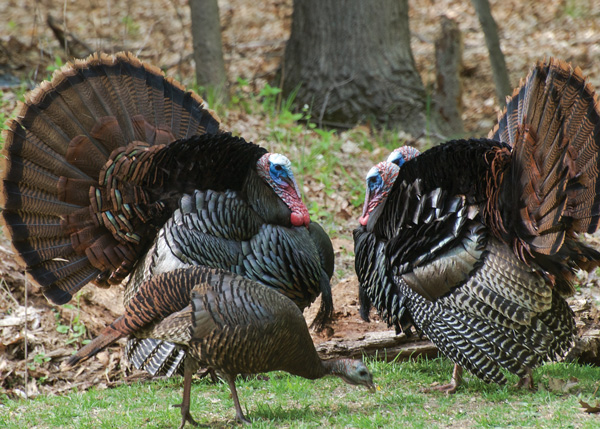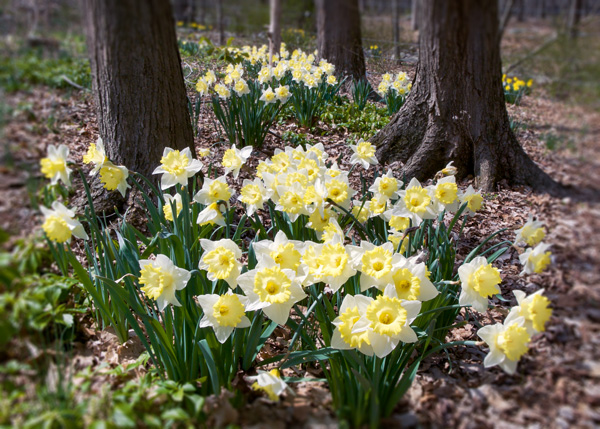This morning a pair of wood ducks replaced the mallards that are the first to appear on the pond behind our house. The wood ducks flew in sometime after dawn. They were there when we woke, nervous birds, flying off as soon as we walked in their direction. For weeks we have heard the gobbles and clucks of turkeys coming from the deep woods, a small flock of hens and another of immature jakes venturing into the yard to peck at the seed under our bird feeders, but lately, toms have appeared strutting onto the pond’s earthen dam, the ducks unimpressed with their elaborate display.

Not long after first light, the sound of Canada geese fills the sky. Chipmunks, popping their heads out from between rock walls, scurry afield, returning to their tunnels with cheeks full of seed found under the bird feeders or an acorn or pig nut left over from the fall. Deer mice, always randy, snuggle in a twig-and-cedar-bark nest between the remaining cordwood that is stacked against the back wall of the woodshed.
Inside our house, Trish has put away the winter decorations and opened the windows to air out the rooms stale with ash and smoke from the woodstove. Ladybugs, awakening earlier in the month, now boldly roll over the bedroom walls, along bathroom cabinets and onto kitchen counters. The dogs spend extended periods of time patrolling the twelve acres surrounding our home, Winslow Homer eager to introduce Finnegan to the old woodchuck whose burrow lies in the field adjacent to my vegetable garden.
The skies are as changeable as the temperature. One moment the sun is shining, the next rain spitting down from constantly shifting clouds. Early this month, winter clung to the evenings, but warmer weather gradually claimed the afternoons and by now temperatures swing from the high forties to the mid sixties and everywhere in between.
Birdsong sweeps up from the lower fields through the winter-weary gardens, filling the trees above the feeders. Goldfinches, having discarded their drab feathers for those of bright yellow, squabble with chickadees, nuthatches and titmice over the last few sunflower hearts. The small flock of bluebirds that returned to our yard for a few days in March to search out houses where they fledged the previous year, reappeared this afternoon, perhaps to spend the season, and raise broods of their own.
Each morning, an extended family of crows sweeps down out of the trees before we awake, flying off when they see us looking out the bedroom window. In the afternoons, a series of raucous cries announces a flock of blue jays that flew in from parts unknown while there was still snow on the ground and now return to peck at any seed left by the turkeys and crows. During the first week of the month, robins joined the jays, stutter stepping across the lawn, their heads sideways, eyes staring toward the damp grass for earthworms.
Under an eave of a lean-to a pair of phoebes has begun construction of their nest of mud. The first birds to return each spring, when not working on the nest, they perch upon wire or post, tails bobbing, ready to swoop down and grab the season’s awakening insects, which include ticks. These parasitic nuisances are now found in every field and beside each stream, wherever there is damp ground.

Daffodils have sprung up along the edges of Trish’s gardens and with the first warm days of the month, their golden flowers spread across the otherwise ashen landscape. The yellow florets of Forsythia bushes are ready to burst forth while the purple flowers of a single Japanese Azalea bloom upon the bush’s naked branches. In the vegetable garden, chives spring back to life and ruffled tips of rhubarb struggle to break through the soft earth.
Although I’d been streamside a half-dozen times during March, the fish were unwilling to rise to my flies no matter how careful the cast or delicate the presentation. Once, while drifting a tiny nymph along the very bottom of a slow moving run I felt a tug, but it could have been a leaf, twig or rock rather than a trout’s attempt to shake off its winter doldrums.
Like the trout, I too must adjust to the new season. There is a rhythm to my fishing, in the way I gather my gear, slip on my waders, decide what imitation to pluck from my fly box, the manner in which I wade the stream, how I hop from one boulder to another, carry my rod, present my flies. This time of year my fingers fumble over knots, my casts miss their target, muscles resisting the hike up the side of the stream, memory tugging at lessons learned, until once more remembered.
This afternoon, with the temperature rising into the sixties and the sun warm on the back of my neck, I tramp down to the same mountain stream where I have spent so many springs, hoping that the fish will once again be looking toward the surface.
In my fly box are a number of Blue Quill patterns meant to imitate these hearty dun-colored mayflies that hatch about the same time that the Forsythia bloom, the nymphs rising from the stream’s bottom, for a few days emerging through the surface film with gossamer wings.
Mayflies, distinguishable from stoneflies and caddis by the way they float upon the current, look like tiny yachts tacking with the wind as they dry their upright wings. Those bugs that survive the trout’s inevitable onslaught flutter upward where phoebes, swallows and cedar waxwings take their share, a silent opera played out under the dark and rain-threatening skies of late April.
This afternoon it becomes evident that there will be no Blue Quills hatching on Bonney Brook, at least not on this afternoon. Staring into my fly box, I decide upon a pheasant-tail, a pattern with a parachute wing that has worked well on days when there is little insect activity.
Flipping my little cane rod over my right shoulder, I flick my forearm forward, propelling the fly over a tiny plunge pool.
It is in that moment, while the little fly flutters over the rush of water that winter a daydream becomes reality, hope is fulfilled, faith restored.
